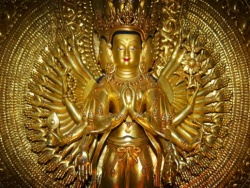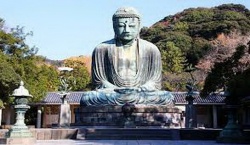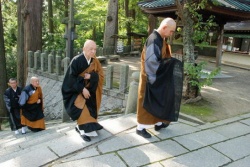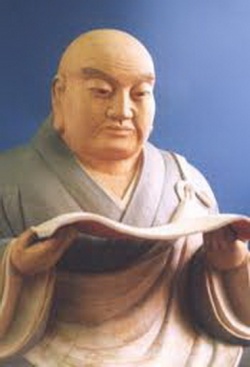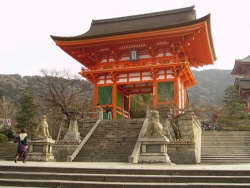One View Of Tendai Buddhism
This writer in 1969 was given the name Vimalakirti after taking refuge in the Three Treasures with Dr. Ajari, a Russian-American and lifelong teacher of religion. In 1992, I became a kozo (junior priest) in the Tendai sect with the name Esho. My teacher is the legendary kaihogyo practioner Enami Kakusho, better known as Gozen-sama. These days he operates out of Sekizan Zen-in at the northeastern edge of Kyoto and at the foot of Mt. Hiei. He has kindly allowed me to offer the kengyo (open teachings).
The ninth-century founder of Tendai is known as Dengyo Daishi, a posthumous title meaning "great teacher and transmitter of the Dharma." After becoming a priest in the Nara Buddhism of the times, he separated himself from that milieu and established a small temple near the top of the then-sparsely populated Mt. Hiei, where he remained confined for twelve years of practice. When the Emporer relocated the capitol from Nara to Kyoto, he came to know Dengyo Daishi, he relied upon his advice, and requested Dharma, then at its height during the Tang Dynasty in China.
Dengyo Daishi's interest in the Lotus Sutra led him to travel to China and receive the transmission from the sect headquartered on Mt. Tien-tai, and he was also successful in bringing back the teachings and practices of Zen teachers, esoteric masters and others. Returning to Japan, he founded a new and vibrant form of study and practice based on the Mahayana ideal of the Bodhisattva, departing from Nara's Hinayana-style Buddhism, and emphasizing various types of samatha-vipasyana meditation. Personally, he was characterized by sincereity, humility, and intelligence as well as a deep devotion to the teachings leading directly to Enlightenment. In a thirty year career, Dengyo Daishi worked diligently and single-mindedly to train disciples to learn, practice, preserve, and hand down beneficial knowledge. In John Stevens' book, The Marathon Monks of Mt. Hiei, he is quoted as saying at the end of his life, "The worthless Saicho (Dengyo Daishi), tired from all his labors, has exhausted his life . . .. I will be gone soon, and have done only two things of merit: never letting harsh words pass my lips nor allowing my hands to injure a living being."
The third patriarch was Jikaku Daishi who brought the full esoteric teaching into Tendai after spending nine adventorous years in China during a period of great civil unrest. One of his disciples inaugurated the kaihogyo tradition, which is my own particular lineage within the very broad umbrella of Tendai Buddhism.
One of the four Bodhisattva Vows is to "master all Dharmas," and this seems to be the impetus for preserving such a wide range of activities within one sect, with the intent of offering practices which can benefit people of markedly different karmas, aspirations, and aptitudes in their quests for Enlightenment. Below, I list separately and in no particular oreder some of the practices. Although I list them separately, they are really intertwined and are to be undertaken in various combinations and at different stages in one's career:
Shikan Meditation (samatha-vipasyana)
Sitting-Only Samadhi
Walking-Only Samadhi
Half-Sitting and Half-Walking Samadhi
Free-Form Samadhi
Amida Worrship and Pureland Disciplines
Repetition of Mantras
Recitation of Sutras and Dharinis
Singing and Chanting
Fire Rituals and Invocation of Fudo Myo-o
Scholarly Study of all Religious Subjects
Ascetic Practices, Fasting, Marathons of Walking
Visualizations of Mandalas and Other Esoteric Practices
Calligraphy - Particularly the Heart Sutra
Keeping the 10 Major and 48 Minor Precepts of the Mahayana
Preserving and Expounding the Lotus Sutra and Other Dharmas
Purifications, Cold-Water Ablutions and Prostrations
Transmitting the Life and Teachings of Sakyamuni Buddha
Offering Healing Ceremonies
Performing Priestly Services Such as Weddings and Funerals
Protecting Mt. Hiei as a Wildlife Range
Maintaining Temples as Places Where People Can Freely Make Offerings,
Pray, Meditate, Chant, Study and Celebrate
Formal Teacher-Pupil Relationships Which Carry the Transmission of the Dharma
Providing the Opportunity for People to Live, Study, and Practice the
Buddha's Way in Accordance with their Special Aptitudes
Making Offerings to the People
Pilgrimmages
Actively Practicing Harmony with Other Sects and Religions
Generating Bodhicitta and Making Vows for the Benefit of All Sentient Beings
Development of Skillfull Means and Perfection of the Paramitas
Relinquishment of Personal Desires and Practicing Harmlessness
Developing a Healthy Vegetarian Regime (shojin ryori)
Visiting Hospitals, Rest Homes, Schools, etc.
Organizing Convocations to Discuss the Dharma
And Possibly Most Important:
Development of Gratitude, Loving Kindness, Friendliness, and Compassion Towards All Living Beings
Although the Tendai sect is extremely broad in scope, and the priests are exposed to virtually all the elements, as individuals they tend to favor or specialize in a limited number of practices for which they have an affinity. The different schools and different individuals within Tendai will have friendly disagreements with each other over the true nature of the Dharma.
For instances, one priest of Dai-Ajari rank, but not a kaihogyo practioner asked me the following questions and then provided the answers as well: "Did Sakyamuni Buddha practice kaihogyo? No! Did he burn goma? No! Did he say prayers? No! Did he recite mantra? No! Did he speak the lotus Sutra? No! Was he a vegetarian? No!"
Differing opinions are welcome here. Founder, Dengyo Daishi had written, "A devout believer in the Buddha's Law who is also a wise man is truly obliged to point out to his students any false doctrines, even though they are principles of his own sect. He must not lead the students astray. If, on the other hand, he finds a correct doctrine, even though it is a principle of another sect he should adopt and transmit it."
I asked the priest if he was a Hinayana or a Mahayana believer (not Hinayana in the sense of Theravada, which has its own profound tradition, including the Bodhisattva ideal, but in the sense of "narrow," or "encapsulated" vs. "broad" or, "infinite" for the Mahayana). He answered that he is definitely a follower of the Mahayana path, but without being a believer in every aspect of Tendai tradition.
The Mahayana tradition as it has come down to us may be understood as deriving from Sakyamuni's final instructions to the Sangha: "Work out your own realization with diligence!" Many lineage holders have done just that over the last 2500 years, and what they have found to be true and beneficial, and in harmony with Sakyamuni's words, that they have passed on to us.
While I have made a listing of the elements found within Tendai, there are others I've overlooked I'm sure . However, it seems that a basic attitude of the sect, reflecting the sincerity of Dengyo Daishi, is that no matter how many Dharmas we practice, this is not the entire Dharma, in fact is only a small portion of the vast Dharmakaya. This attitude spurs one to abandon self-satifaction, laziness, and arrogance, and to learn more and go deeper, to frequently meet with the Sangha and ask their opinions and experiences, and to again and again enter into samadhi.
